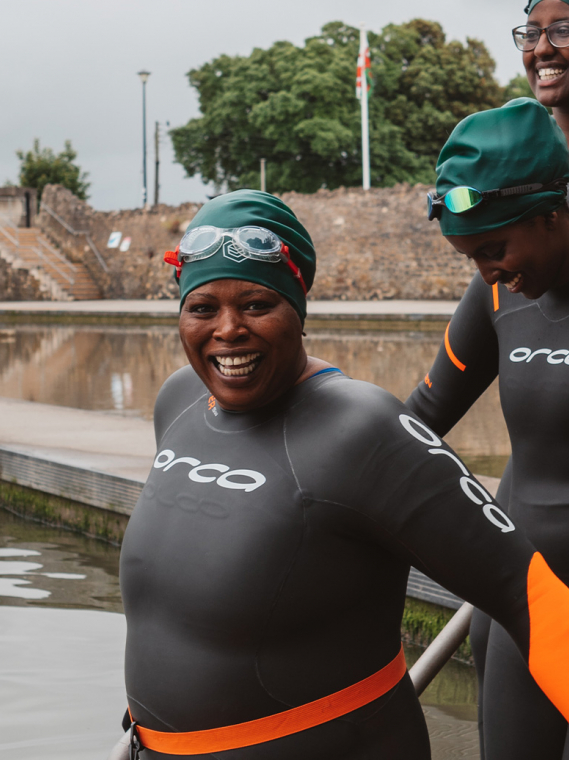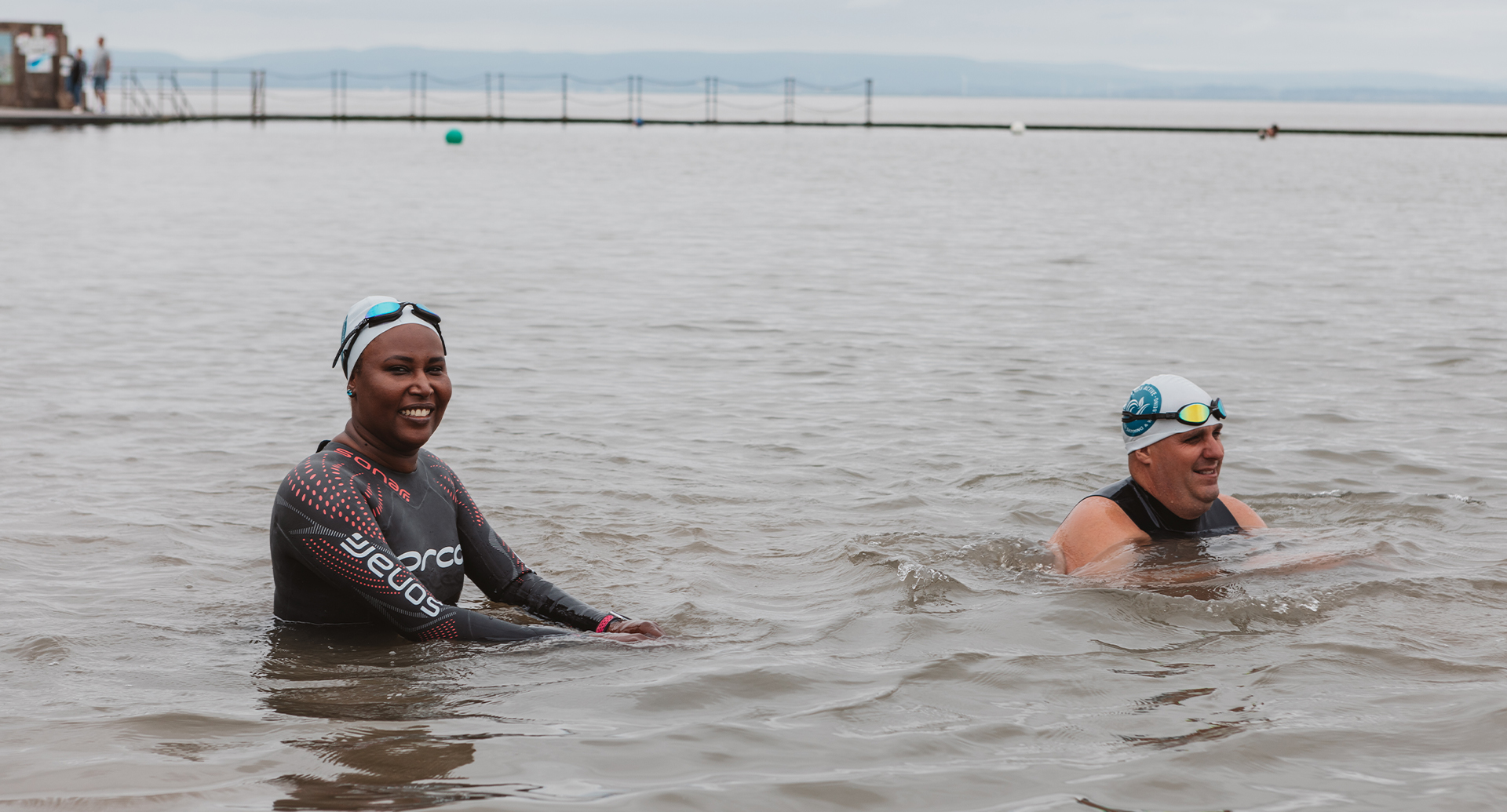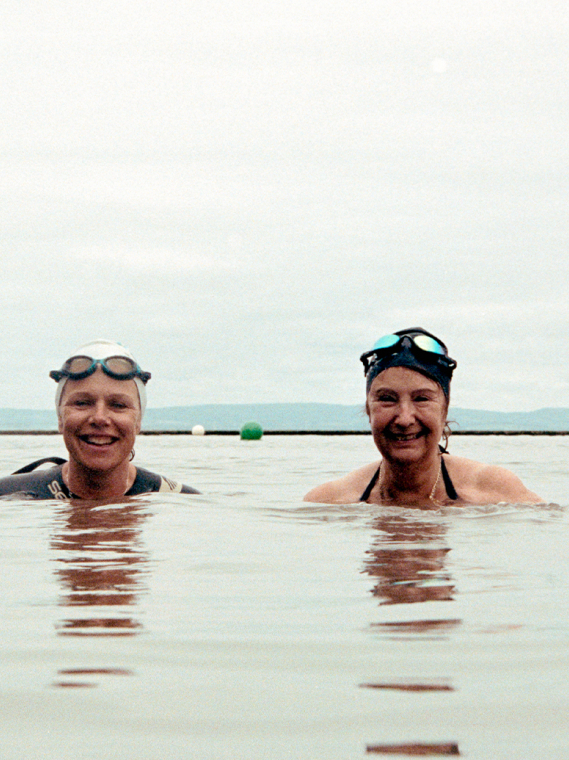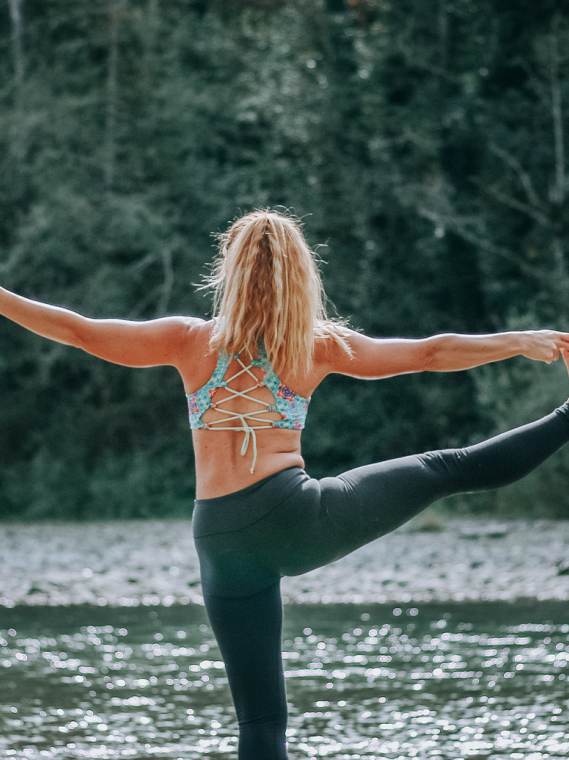Kiki Watkin, Open Minds Active swim coach recounts how she caught the cold-water swimming bug and shares her useful tips for those looking to get started.
KIKI WATKIN - Open Minds Active member
HOW IT ALL STARTED
When it comes to swimming in the colder months, a particularly vivid memory flashes through my mind of where my winter swimming journey started. It was late summer 2019, and I was in Clevedon Marine Lake, near Bristol swimming with friends. It was a beautifully warm mid-September day, the temperature had started to drop a little at night, the darkness had begun to creep into the early mornings and evenings, and you had a sense that change was in the air. We had just come out of the water after a lovely swim, and I was in my happy place, smiling and feeling immersed in the moment. Sarah then uttered the statement, “Let’s keep doing this through October and November and see where we get to; we might even make it through the winter!” I grinned, nodded my head in agreement, and thought, what a great idea.
Until that moment, my outdoor swimming had taken place in the spring and summer, and only indoors in the winter. Winter swimming hadn’t massively crossed my mind before that moment. Fast forward three years, and I’m heading into my third winter training as an Open Water Swim Coach and now deliver outdoor swimming as part of Social Prescribing projects - which run all through the year. Those that have known me long enough will know that the colder months, for me, are not my best, just able to get through the long dark winter months, longing to hibernate, much like a bear. Winter swimming completely changed that. It gets you out in nature, it helps you feel at one with your environment, and can make you feel like you can handle whatever life throws at you, “bring it on - come on - I’m ready!”

WHY DO WE DO IT
The benefits of cold-water swimming related to our well-being and mental health are well documented; people are starting to consider cold water therapy to help with their anxiety, social isolation, depression, and physical well-being too. GPs are socially prescribing outdoor swimming to their patients; at Open Minds Active, we run our social prescribing throughout the winter. So far, the benefits that we have seen have been utterly transformative; one of the main well-being benefits is that cold water decreases your stress response. They help us to deal with our day-to-day life in a less stressful way. We have seen our social prescribing members blossom whilst participating in our outdoor swimming, helping them form new friendships, decreasing dependency on sleeping tablets, improving their confidence, and learning a new skill. The evidence is impressive!
There are many reasons why people decide to take to the water in the colder months, and if you are contemplating venturing into the cold, you need to consider some things when starting this Autumn. Firstly, go slowly and carefully; it’s all about preparation. If it’s your first foray - check it out and see if it’s for you; always go with a buddy. One of the main benefits of winter swimming is camaraderie; see if someone you know might be interested in joining you. Either you could start a group yourself or find a locally established group; Facebook is an excellent place to start for this.

PREPARATION
Preparation is vital for swimming in cold water. One good idea is to create a ritual, something you always do before you go, such as making a cup of tea/coffee/herbal tea, having some food, or preparing something to take with you. My essential ritual is making a hot water bottle. I wrap my towel around mine, and when I get out, my towel is warm - heaven! I then warm my kidneys with it. A woolly hat is an essential piece of kit. I also have a belly warmer, aka Hari Maki, which I find invaluable. I feel the cold, so I take something to stand on when getting changed. A gardening mat is good, or a waterproof bag, the ground is very cold in winter, which helps keep your feet warm. Layering your clothes in the order you will put them back on is a good idea too. Bringing some cover for your kit is a good idea for when it rains, to keep your clothes dry when you are in the water. Please don’t bother with fiddly bras, girls; it’s not worth it! Or leggings, as they are tricky to put on afterward. Keep clothing loose, warm, and comfortable.

WHAT TO WEAR IN THE WATER?
Some have every inch of flesh covered with neoprene, and others wear just a swimming costume. I personally don’t wear a wetsuit during my winter swims. And I feel I get more of an intense cold rush if I’m just in skins. I wear a thermal hat, as we lose a lot of heat from our head, and thermal swim gloves and booties make a huge difference in protecting our extremities. The pain in my fingers and toes can be too much to bear if the water is under 10 degrees. These make my dips a lot more pleasant.
GETTING IN
Get in slowly, no jumping in here, breathe, lie on your back, float and take a few deep breaths once you have slowly entered the water, don’t underestimate the cold shock response; it immediately makes us want to take a gasp of air and puts our body under stress. This stress response will lessen as you slowly build up your acclimatization to the cold, but always take it slow and listen to your own body, don’t compare yourself to anyone else. How long you can stay in will depend on quite a few factors: on your body, how tired you are, whether you have eaten, if you have your period, if you are hungover. These are just some of the variables and environmental factors to consider, such as weather, wind chill, and temperature.

HOW LONG SHOULD I STAY IN FOR?
The eternal question when winter swimming. How long can I stay in the water? There is no hard and fast rule on this one, and you may hear something like “one minute per degree.” Everybody is different, you are unique, and how much time people will spend in the water will vary from person to person. Start carefully, see how you feel, build up your time gradually. The one thing to know is that plunging yourself into cold water will help you understand your body and how it responds to the cold. You will get to know your limits. You will feel parts of you ache you didn’t know could. As a rule of thumb, don’t push yourself to stay in longer than you should; always exit the water wanting more.
BEAT THE WINTER BLUES
Approaching my third winter swimming season, I’ve come to realize that I don’t dread winter in the same way as before. I still miss the sunlight, but who doesn’t? Winter swimming gets me up earlier, and I get to see sunrises, sunsets, and moonrises all from the water’s edge and in the water. I get to share this with like-minded friends and have met loads of new swim buddies with whom I’ve shared plenty of cake, and I feel happier in winter. I’ve shared incredible and joyful moments with friends and strangers and shared grief too, it all comes out in the water. When you get in the water, I guarantee that you enter a realm in which transformation is inevitable. It’s just one of those things that happen. You exit the water a better version of yourself, more able to cope with day-to-day life. Please don’t take my word for it; try it. It’s so good your local GP is now prescribing it. Who saw that coming?

ABOUT KIKI WATKIN
Kiki’s love of swimming started at a very early age, training with Olympians and competing at county and national levels. Swimming has always been her first love. She finds swimming outdoors exhilarating, liberating, and soul-defining. She runs the Open Minds Active wild swimming social prescribing program and learn to swim sessions.
Instagram profile.
ABOUT OPEN MINDS ACTIVE
Open Minds Active is a Bristol social impact organization that promotes positive mental health and well-being through wild swimming and the outdoors by nurturing a deeper human connection with nature.
Open Minds Active website.








